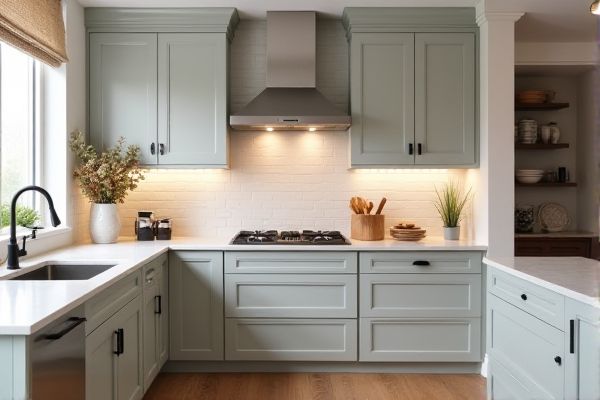
Deep upper cabinets offer increased storage capacity, ideal for bulky kitchen items, while standard upper cabinets provide easier access and better visibility for everyday essentials. Explore the advantages and design tips to choose the perfect cabinet depth for your kitchen needs.
Table of Comparison
| Feature | Deep Upper Cabinets | Standard Upper Cabinets |
|---|---|---|
| Depth | 16-24 inches | 12-15 inches |
| Storage Capacity | High - can store bulky items and large dishes | Moderate - best for plates, glasses, and small containers |
| Accessibility | Lower accessibility; items at the back are harder to reach | Better accessibility with easy reach to stored items |
| Visual Impact | Creates a bulkier, more substantial look | Sleeker, less imposing appearance |
| Installation | Requires stronger wall support due to weight | Standard wall support suffices |
| Cost | Higher cost due to increased materials | Typically more affordable |
| Common Use | Ideal for kitchens needing extra storage space | Suitable for standard storage and smaller kitchens |
Introduction to Upper Cabinets
Deep upper cabinets typically measure 15-24 inches in depth, offering increased storage capacity for bulkier kitchen items, while standard upper cabinets usually range from 12-15 inches deep, optimizing space without overwhelming the kitchen layout. Choosing deep upper cabinets enhances functionality by accommodating larger dishes, small appliances, and pantry goods, making them ideal for extensive kitchens or avid home cooks. Standard upper cabinets provide a streamlined, accessible storage solution, maintaining an open visual flow and fitting seamlessly within most kitchen designs.
What Are Standard Upper Cabinets?
Standard upper cabinets typically measure 12 inches deep, offering ample storage for everyday kitchen essentials like dishes, glassware, and spices. These cabinets are designed to maximize space efficiency while maintaining easy access and visibility, fitting seamlessly above countertops and appliances. Compared to deep upper cabinets, standard ones provide a balanced solution for kitchens prioritizing both storage capacity and ergonomic design.
What Are Deep Upper Cabinets?
Deep upper cabinets typically extend 15 to 24 inches in depth, offering significantly more storage space compared to standard upper cabinets, which are usually around 12 inches deep. These cabinets maximize vertical storage in kitchens, accommodating larger items and reducing clutter on counters. Choosing deep upper cabinets can enhance your kitchen's functionality by providing easy access to cookware and pantry essentials while maintaining an organized and sleek appearance.
Key Differences: Deep vs. Standard Upper Cabinets
Deep upper cabinets offer increased storage capacity with a typical depth of 15 to 24 inches, compared to standard cabinets that usually measure 12 inches deep. This extra space allows you to store larger kitchen items like stockpots and small appliances more efficiently. Choosing between deep and standard upper cabinets impacts kitchen organization and accessibility, aligning with your specific storage needs and kitchen layout.
Storage Capacity Comparison
Deep upper cabinets offer significantly greater storage capacity compared to standard upper cabinets, typically extending 15 to 24 inches in depth instead of the standard 12 inches. This increased depth allows for larger or bulkier kitchen items, such as tall dishes, small appliances, and pantry goods, to be stored efficiently. Homeowners prioritizing maximum storage often choose deep upper cabinets to optimize space utilization in kitchens with high storage demands.
Accessibility and Usability
Deep upper cabinets offer greater storage capacity, allowing you to store bulkier items, but they can reduce accessibility since items at the back are harder to reach. Standard upper cabinets provide easier usability with better visibility and access, making daily use more convenient. Choosing the right depth depends on your kitchen layout and how frequently you need to access stored items.
Impact on Kitchen Space and Layout
Deep upper cabinets expand storage capacity by offering more room for bulky items without sacrificing floor space, making kitchens feel less cluttered and more organized. Standard upper cabinets maintain a streamlined look and provide easier access to frequently used items, contributing to an efficient workflow. Choosing between deep and standard cabinets directly influences kitchen layout flexibility, functionality, and overall spatial perception.
Aesthetic Considerations
Deep upper cabinets create a bold, substantial look by extending further into the room, adding visual weight and a sense of luxury to kitchen spaces. Standard upper cabinets maintain a streamlined, minimalist aesthetic, providing clean lines and a balanced proportion that complements modern design trends. Selecting cabinet depth significantly influences kitchen style, where deeper cabinets emphasize richness and presence, while standard depths promote openness and simplicity.
Cost and Installation Differences
Deep upper cabinets generally cost more due to increased material use and heavier weight, which can also lead to higher installation expenses. Standard upper cabinets are lighter and easier to install, often resulting in lower labor costs and quicker installation times. Your choice affects the overall budget and timeline, with deeper cabinets requiring more structural support during mounting.
Choosing the Right Upper Cabinets for Your Kitchen
Deep upper cabinets, typically 15-24 inches deep, offer increased storage space ideal for bulky kitchenware and large dishes, enhancing kitchen organization efficiently. Standard upper cabinets are usually 12 inches deep, providing a sleek, streamlined look while maximizing wall space for smaller kitchens or minimalist designs. Selecting between deep and standard upper cabinets depends on your kitchen's layout, storage needs, and aesthetic preferences to balance functionality with style effectively.
 homyna.com
homyna.com